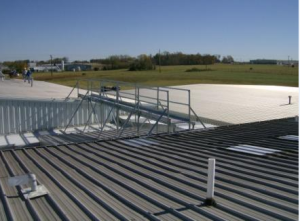With the onset of winter, one might think that there is less of a need to think about fall protection. In much of the country, the arrival of snow and ice means there is less activity on rooftops. With proper planning, facilities managers can knock out the vast majority of their regularly scheduled rooftop maintenance during the warmer months. Although the change of seasons should lessen the demand for new fall protection system installations, every winter we hear from clients with unanticipated emergencies that require safe rooftop access. We also receive inquiries from clients with buildings in areas of the country known for large accumulations of snow and ice. When you combine routine nasty winters, aggressive wind patterns and a quirky roofline, you end up with a recipe for slips, trips, and falls.
The picture to the left illustrates an OSHA compliant rooftop walkway connecting two buildings with pitched roofs and a lower section of flat roof. Thanks to the roof’s orientation to the sun and prevailing winds, the flat lower section is shady and prone to ice buildup and drifting snow during the winter months. Building maintenance and EHS personnel only have access to one section of the roof from inside the building, but need access to both sections of the roof to service air handling equipment and monitor emissions to ensure compliance with EPA air quality standards.
There are several available options to provide maintenance personnel with rooftop access. One “unsafe” option is climbing down a ladder, traversing the flat, icy section, and climbing up another ladder to access equipment on the other side of the roof. The second option is construction of a rooftop walkway to provide safe and efficient access to the air handling equipment servicing this plant.
Although some fall protection companies build rooftop walkways using traditional structural steel fabrication techniques, we completed our project with stock sections of Unistrut framing channel and skid-resistant grating. Using Unistrut to complete this project provides two key advantages over other fabrication methods. For starters, no welding is required. Connection of the walkway’s structural members and handrails requires nothing more than bolts, nuts, and hand wrenches. More importantly, a crane is not required to lift the finished structure into place. The finished rooftop walkway is 6 feet high and 2-1/2 feet wide, features toe boards, and OSHA compliant mid-rails at 21 inches in height and top-rails at 42 inches in height.
If the snow and ice-prone winter months is creating a need for safe rooftop access at your facility, contact the safety experts at Diversified Fall Protection. We have years of design, fabrication, and installation experience that will keep your personnel safe and your facility in compliance with OSHA fall protection regulations. To learn more about wintertime rooftop fall protection or to discuss a project, contact Diversified Fall Protection for further assistance.


